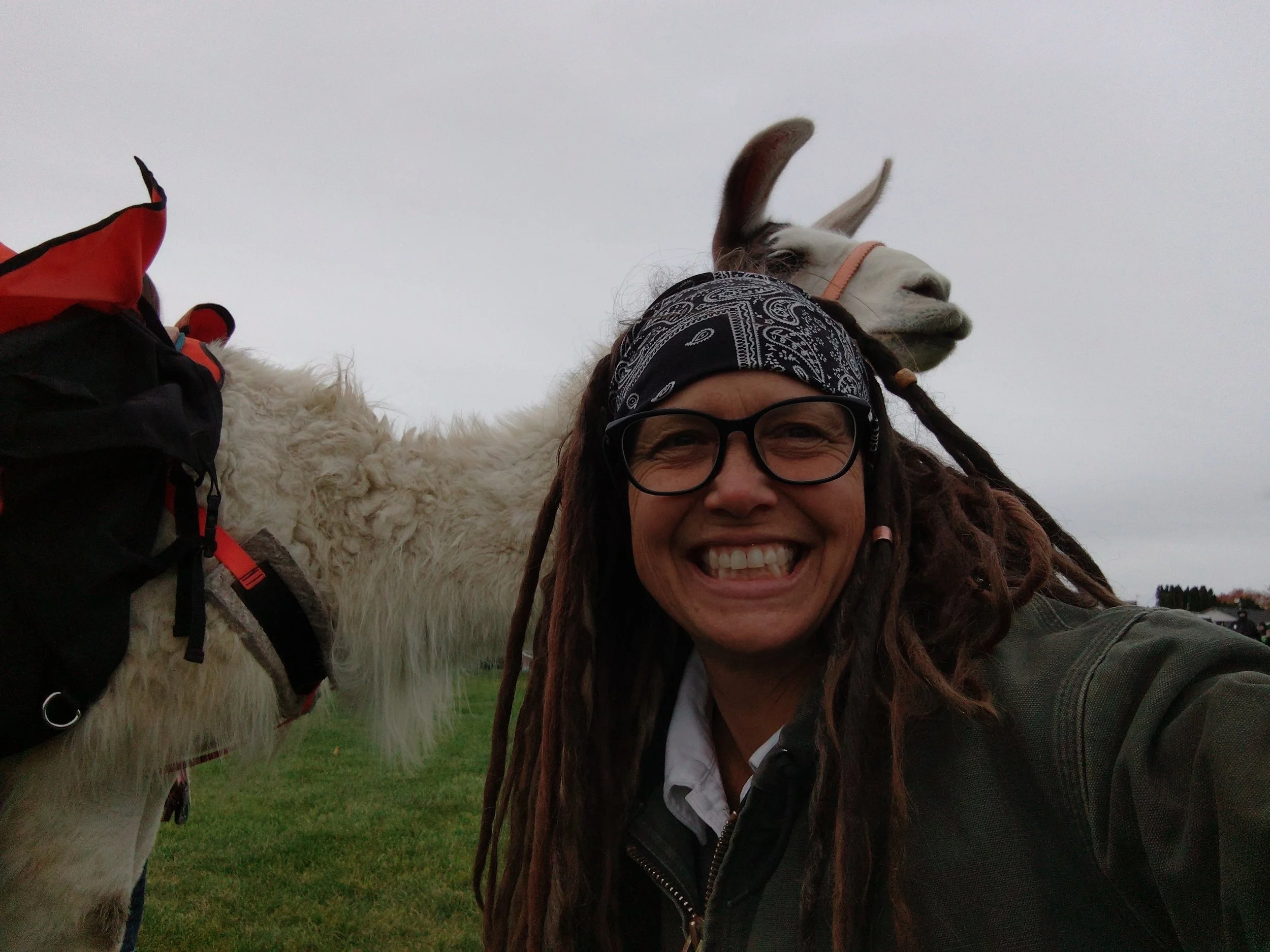
How the Moore’s Got Started with Llamas:
It All Began with Stromboli …
For as long as we can remember, our family has been drawn to the wild places — the kind of places you can only reach on foot, where the air is crisp, the silence is deep, and the stars and moon shine bright enough to guide your steps. We have always loved hiking, backcountry adventures, and the kind of rugged simplicity that comes from time spent in nature. We discovered that we loved sharing those experiences with animals.
That is how our llama story began — with a desire to spend more time in the wilderness and a deep respect for the companionship animals bring to the journey.
Our first llama was named Stromboli. Looking back, we could not have asked for a better teacher. Stromboli was more than just a pack animal; he was a patient mentor, a trail companion, and a reminder that the best lessons often come from experience!
Stromboli taught us balance — quite literally. We learned to pack panniers with equal weight so that every mile of the trail was fair to both sides. We learned that preparation matters: conditioning for both llama and human is key if you want to face whatever the wilderness might throw your way.
He also taught us the value of work ethic and endurance. Stromboli hiked countless miles with us, carrying gear and hunting harvests across rugged terrain. He stood guard over our camps, alert and steady, and helped us raise our younger llama boys to understand the same responsibility, trail sense, and respect for nature’s rhythms.
Through Stromboli, we discovered that working with llamas isn’t just about utility — it’s about partnership. It’s about learning to move at a more intentional pace. It’s about stewardship, resilience, and the joy that comes from being in God’s creation.
That one llama began what has now become a family passion. Today, our herd has grown, and so has our love for these incredible animals. Stromboli is no longer with us, but no matter how many trails we travel or llamas we train, we will never forget where it all started — with Stromboli, the llama who taught us how to walk the wilderness well.
Why Use Llamas as Backcountry Pack Animals?
It all begins with an idea.
If you have ever dreamed of exploring the backcountry, you know that carrying everything you need on your back can quickly turn a dream into a test of endurance. This is where llamas come in!
At first glance, llamas might seem like an unusual choice for a pack animal. Llamas are not as large as horses or mules, and they don’t have the rugged image of a mountain goat. But once you’ve spent time in the wild with llamas, you begin to understand: they are uniquely made for this kind of adventure.
1. Llamas Are Born for the Mountains
Llamas come from the high Andes of South America, where steep terrain, rocky trails, and thin air are part of everyday life. Their sure-footedness on narrow trails and uneven ground makes them ideal for traversing rugged country. Unlike heavier animals, llamas tread lightly, minimizing trail impact and erosion. They move gracefully where other pack animals struggle.
2. They’re Low-Impact and Environmentally Friendly
Llamas have soft, padded feet—similar to a dog’s paw—which makes them gentle on delicate alpine ecosystems. They do not leave deep hoof prints or tear up trails, and they browse lightly rather than overgrazing. For those of us who love the wilderness, llamas offer a way to travel responsibly and sustainably through fragile terrain.
3. They Carry the Weight—Not the Waste
An average adult llama can comfortably carry 25 - 30 percent of their body weight (depending on terrain, distance, and conditioning) which means you can hike farther and enjoy the journey without being weighed down. Because they browse on available vegetation and drink less water than many other pack animals, you can travel lighter and farther with fewer supplies. And since llamas are efficient eaters, they produce less waste—making cleanup simple and your campsite cleaner.
4. Calm, Curious, and Companionable
Llamas (typically) have gentle temperaments and calm dispositions. They tend to be be alert, they are not typically skittish, they are curious and respectful. When you spend days hiking with llamas, you begin to form a bond—one built on mutual trust.
5. Easy Keepers
Llamas require minimal equipment and maintenance. They don’t need shoes, special tack, or grain. A well-fitted halter, panniers, a lead rope ~ and supplemental feed are often all that’s required. At camp, they will happily graze nearby and bed down quietly for the night. Their efficiency makes them perfect companions for hunters, photographers, and hikers who want to focus on the experience.
6. Great for Families and Beginners
Llamas are approachable animals, making them a great choice for families or those new to packing. Children often find them fascinating and less intimidating than larger animals. Often times, other hikers enjoy encountering a llama string on the trail. Their size, demeanor, and cooperative nature make them a perfect introduction to backcountry travel with animal partners.
7. They Let You Go Farther—and Enjoy More
At the end of the day, using llamas as pack animals allows you to explore farther, stay longer, and enjoy the wilderness more fully. They make it possible to carry a few comforts—better food, a cozy tent, or that extra camera lens—without sacrificing mobility. Llamas don’t just carry your gear; they expand your experience.
Final Thoughts
Once you have experienced a trip with llamas, it will be hard to imagine going back. They embody everything you want in a backcountry companion—strength, steadiness, and serenity. Whether you’re a seasoned adventurer or setting out for your first wilderness trek, llamas make it possible to journey deeper into the wild with a lighter load.
Llama Visits: How to Bring the Magic to Your Event
There’s something unforgettable about a llama entering a space—the calm presence, the expressive eyes, the instant smiles. Llamas add charm, joy, and a touch of whimsy to any gathering. Here are some of the best ways to bring llama magic to your next event.
Living Nativities
As members of the camelid family, llamas add a meaningful and memorable touch to Living Nativity scenes. Their gentle demeanor, quiet nature, and steady presence make them perfect for church events that draw families and create wonder.
Fall Festivals
Llamas are a natural fit for autumn celebrations. Families love:
Cozy fall-themed photo ops
Short llama walks
Meet-and-greet pens
They bring a warm, festive feel to any harvest event.
Weddings
Yes—llamas at weddings are pure magic.
Perfect for:
Unique couple or guest photos
Rustic, boho, or whimsical themes
Their calm presence and elegant look create unforgettable moments guests talk about for years.
Birthday Parties
Make the birthday child’s day with a llama guest!
Llama parties can include hands-on time, fun facts, and photos. It’s a unique, joyful experience kids absolutely love.
College Campus Visits
Llamas are surprisingly effective stress relievers. Colleges bring llamas for:
Finals-week breaks
Welcome-week events
Mental-health awareness days
They draw crowds, spark smiles, and create instant campus buzz.
Vacation Bible School
A llama visit is a memorable kickoff or finale for VBS. Linked to themes like God’s Creation or global missions, llamas help kids engage, learn, and wonder.
Why Llamas Make Events Special:
Llamas bring a calming, friendly presence; interactive fun, they offer fantastic photos and a unique experience that guests remember. Bring llama magic to your event!
From weddings and festivals to church programs and campus events, our gentle, well-trained llamas are ready to make your special day unforgettable.
Contact us to check availability—especially during fall and holiday seasons!







